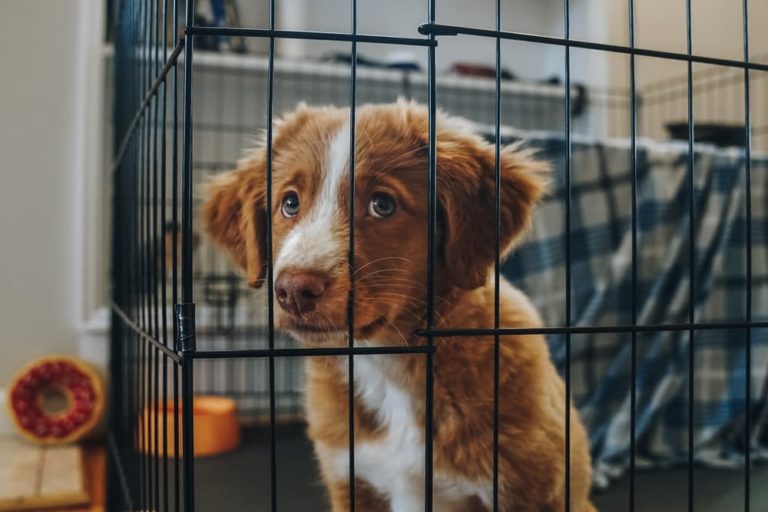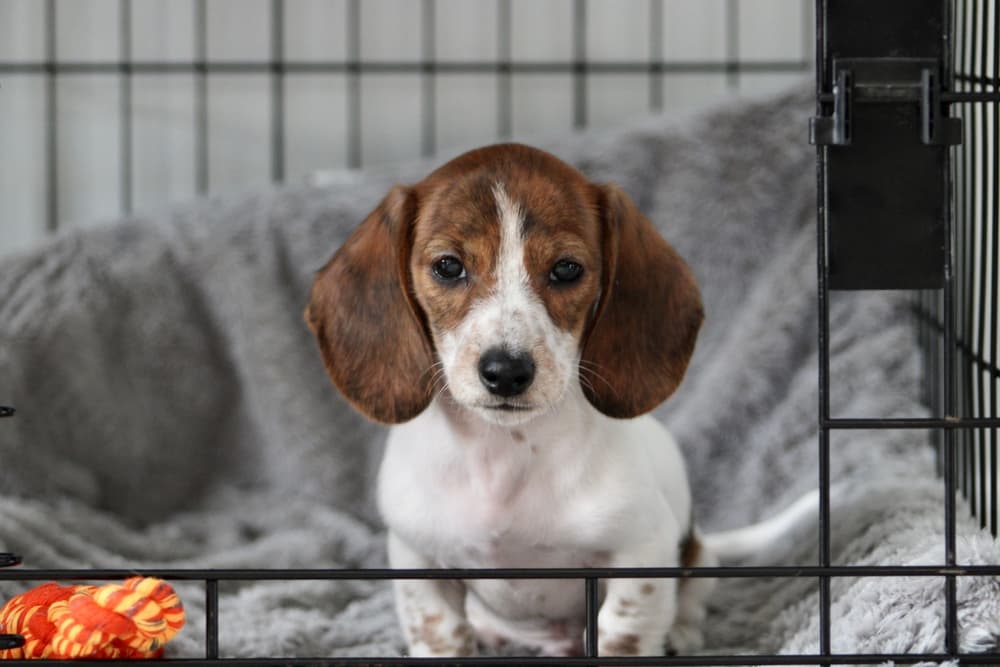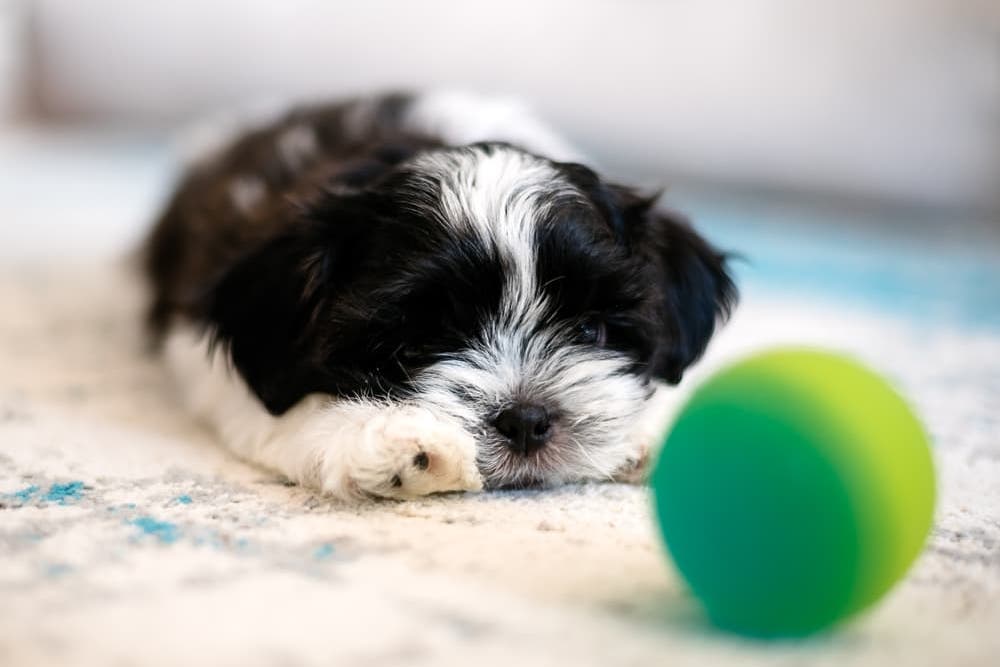Puppy Crying in Crate: What You Should Do

You want your adorable new puppy to consider their crate a place of refuge — a quiet, cozy, safe space that’s perfect for naps and sweet dreams at night. But what happens if your pup isn’t feeling so great about their crating situation? Many new pet parents wonder what’s the best way to deal with a puppy crying in the crate.
When crate training a puppy, a certain amount of whining is to be expected, particularly during the introductory stages. But how much canine complaining is too much? And what exactly should you do when you’ve got a crying puppy on your hands?
Worried pet parents, read on to understand why your pup might be crying in the crate, as well as training tips and tricks for dealing with puppy whining.
Puppy Crying in Crate: What to Expect

A crate is an important training tool during puppyhood. Not only does it streamline the potty training process, but it also keeps your pup safe from harm when you’re not able to watch them. That said, it takes gradual training to make sure your pup feels comfortable inside their new home. And even with a slow and steady introduction to the crate, it’s natural for your pup to resort to occasional whining while inside.
Pet parents need to remember that whining is an important form of communication. Puppy cries can signify anything from pain, to hunger, to boredom, and everything in between. That’s why it’s important to respond to your pup’s cries and ensure their basic needs are being met. Some whining in the crate is natural, but a puppy screaming in the crate for hours is definitely a sign that something is wrong.
How Long to Let Puppy Cry in Crate

When it comes to determining how long to let a puppy “cry it out” in the crate, the answer is: probably shorter than you think!
A young puppy just getting used to a new home is likely to be nervous about the unfamiliar environment. Letting an anxious pup cry in their crate for too long could just compound their stress and might even make them reluctant to use the crate.
You don’t want to leave an older puppy barking in the crate too long, either. Older puppies might cry or bark to signal the need for a potty break, so a prompt response could help you avoid a mess. But your pup might also be letting you know they still have plenty of endless puppy energy to burn. Over-crating a puppy can lead to a multitude of problems, including crate resistance and increased barking. So remember that the crate is a tool and not a lifestyle.
Causes of Puppy Crying in the Crate & What To Do

It may take you a little time to learn how to decode the meaning behind your crated puppy’s crying and whining sounds. Does that cry mean your pup’s a little lonely or in desperate need of a bathroom break?
But it helps to know some of the most likely reasons why a crated puppy might whine or cry for your attention, which include the following:
- Fear/isolation distress – Typically occurs when a puppy feels uncomfortable being left alone
- Elimination whining – Indicates the puppy needs a potty break
- Boredom – The puppy may not have gotten enough exercise prior to being crated
- Hunger – When the puppy realizes it’s close to mealtime
- Pain – Often points to an ongoing health issue, like teething, or there might be an issue related to the crate itself, like a paw caught in the crate
Since there are many reasons why a puppy might be crying while in the crate, pet parents should try to determine the reason for the puppy whining before attempting to deal with it. In some cases, ignoring the crying for a very brief time could be the right choice. But if the crying escalates or persists, your puppy is likely trying to let you know they need something. Delaying too long could result in undue stress for your pup or a mess for you to clean up.
How to Respond to Typical Puppy Whining Scenarios

To help pet parents learn how to understand and respond to a puppy crying in a crate, we outlined some common scenarios and solutions.
Puppy crying at night
Potential causes: Fear/isolation distress, elimination whining
The most likely reason for a puppy crying in the crate at night is the need to go out for a bathroom break. Young pups under 12 weeks usually can’t last through an entire night. So if your puppy wakes you in the middle of the night, it usually means you need to head outside for a potty walk ASAP.
However, pups that are crated in a room by themselves at night might also be suffering from isolation distress. Pups should spend the night crated close to people so they don’t feel abandoned.
Puppy whining in crate when you leave the room
Potential causes: isolation distress, boredom
This type of crying usually happens during the early stages of crate training, while the pup is still getting used to being in the crate on their own. Make sure that you’re progressing through your pup’s alone-time training slowly. And always exercise your puppy and take a quick trip outside for a potty break before putting them in, to eliminate other causes of crying. It also helps to leave your puppy with a safe, treat-stuffed busy toy when in the crate to keep them occupied.
Puppy crying in crate all of a sudden
Potential causes: pain, hunger, elimination whining
A puppy that’s been quiet and suddenly launches into crying might need to go outside for a potty trip. However, this type of puppy barking could also signal physical discomfort. A sudden outburst might mean your puppy is ready for the next meal. Or, in some cases, it might signal some sort of physical discomfort.
What if Puppy Won’t Stop Crying in the Crate

If you feel like you’re trying everything, yet your puppy still won’t stop crying in the crate, here are some key troubleshooting tips to try:
- Go back to basics. Leaving a new puppy alone in a crate for long periods of time before they are ready is a recipe for a very unhappy pup. You may need to reset by starting your puppy out with very short periods of alone time in the crate. Then, once they are comfortable, slowly and gradually increase the duration over time.
- Keep the crate in a populated location during the day and a bedroom near people at night to prevent isolation distress.
- Go on a potty walk just before you crate your pup and immediately after letting them out, every time.
- Offer your puppy a safe chew toy or treat-stuffed puzzle toy to play with when they are crated to encourage a positive association. Supervise play to make sure your pup remains safe.
- Provide enough exercise before crating to ensure a worn-out pup.
Puppy Crying and Whining in Crate: When to Worry

A certain amount of puppy whining in the crate is part of the crate-training territory. However, for puppies that never settle down in the crate or injure themselves trying to escape, pet parents may have to reconsider whether crating is appropriate.
Although crating is a solution that works for many dogs, some dogs are resistant to close confinement. A trainer can help determine if behavioral modification can address the issue, or if an alternate confinement solution — such as a puppy-proofed powder room or secure exercise pen — might be a better fit.
Crate Training Puppy Tips for Success

For most puppies, crying and whining in the crate is a temporary phase that’s simply a part of growing up. However, those cries can sometimes weaken the resolve of even the toughest pet parent. To help pet parents ensure crate training success, here are some pro tips to keep in mind.:
- Never punish your puppy for whining in the crate. Whining is communication which means your puppy is trying to tell you something.
- Try feeding your puppy inside the crate to help foster a positive association with being inside.
- Hide high-value treats inside the crate for them to discover when they return to the crate. Before long, you may notice that they enter eagerly in the hopes of finding a treat.
- Don’t over-crate your puppy. Remember that pups have limited “hold times” so don’t force a pup to stay in the crate for longer than they’re physically able.
- Consider using a white noise machine near the crate to blot out ambient noises.
- Vary the length of your pup’s crate times, doing some sessions as short as fifteen minutes so the crate doesn’t become a symbol of extended alone time.









